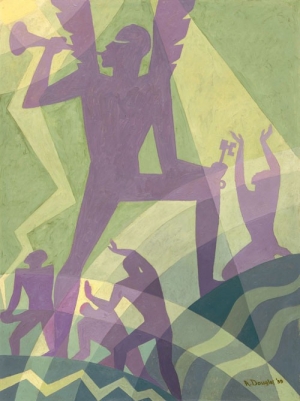Duncan Phillips incorporated his modern gallery in the midst of a personal family tragedy—the deaths of his father in 1917 and his brother from influenza in 1918—and a national tragedy overseas—the deaths of thousands of young soldiers following America’s entry into World War I in spring 1917. Shortly after the war ended, Phillips helped to organize the Allied War Salon, an exhibition devoted to military images and soldiers’ art, as he was making initial preparations that would lead to the opening of the Phillips Memorial Gallery in 1921.[1] A little over two decades later, and following the death of his own father in 1937, Paul Mellon would see the National Gallery of Art come to completion in 1941 in the midst of World War II. After the bombing of Pearl Harbor in December, the Gallery’s activities were dominated by the war effort. There were nightly blackouts. The most important works of art were evacuated to George Vanderbilt’s Biltmore estate in the mountains of North Carolina. Exhibitions were devoted to war posters and the works of war artists. And in 1943, the Gallery became the headquarters for the American Commission for the Protection and Salvage of Artistic and Historic Monuments in War Areas.
- Albright, Ivan
- Baer, George
- Bellows, George
- Benton, Thomas Hart
- Bluemner, Oscar F.
- Bruce, Patrick Henry
- Curry, John Steuart
- Davies, Arthur B.
- Davis, Stuart
- Dearth, Henry Golden
- Dodd, Lamar
- Douglas, Aaron
- Dove, Arthur
- Emmet, Lydia Field
- Hartley, Marsden
- Henri, Robert
- Hopper, Edward
- Jonson, Raymond
- Kent, Rockwell
- Kuhn, Walt
- Kuniyoshi, Yasuo
- Marin, John
- Marsh, Reginald
- Myers, Jerome
- O'Keeffe, Georgia
- Pène du Bois, Guy
- Pippin, Horace
- Prendergast, Maurice
- Sheeler, Charles
- Sloan, John
- Soyer, Raphael
- Steichen, Edward
- Tucker, Allen
- Weber, Max
- Wood, Grant
- Show all works
- The Aero
- Anne with a Japanese Parasol
- Bather Seated on Rocks
- Berlin Abstraction
- Bizarre
- Blue Morning
- Both Members of This Club
- Buildings with Snowbank, Cliffside, New Jersey
- Cape Cod Evening
- Catharine
- Circus Elephants
- Citadel
- The City from Greenwich Village
- Classic Landscape
- Club Night
- Corn and Winter Wheat
- Cows in Pasture
- Flecks of Foam
- Florence Sittenham Davey (Mrs. Randall Davey)
- Forty-two Kids
- Green Apples and Scoop
- Grey Sea
- Ground Swell
- Hallway, Italian Restaurant
- Harriet Lancashire White (Mrs. Edward Laurence White) and Her Children, Sarah and Laurence
- Haying
- House with Dutch Roof
- Imagination
- Indian Girl in White Blanket
- Into Bondage
- Jack-in-Pulpit Abstraction - No. 5
- Jack-in-Pulpit - No. 2
- Jack-in-the-Pulpit No. 3
- Jack-in-the-Pulpit No. IV
- Jack-in-the-Pulpit No. VI
- The Judgment Day
- Landscape No. 5
- Landscape with Figures
- La Rue de la Santé
- Le Tournesol (The Sunflower)
- Life on the East Side
- Line and Curve
- Little Girl in White (Queenie Burnett)
- The Lone Tenement
- Maine Woods
- Marie Jane Hughes Marin (Mrs. John Marin)
- Masouba
- Maud Murray Dale (Mrs. Chester Dale)
- Moon
- Moth Dance
- Mount Katahdin, Maine
- Multiple Views
- My Family
- New Road
- New York
- Nude with Red Hair
- Olivia
- Peinture/Nature Morte
- Pierrot Tired
- The Politicians
- A Railroad Station Waiting Room
- Rush Hour, New York
- School Studies
- Smokehounds
- Snow in New York
- Space Divided by Line Motive
- Stars and Dews and Dreams of Night
- Study for "Swing Landscape"
- There Were No Flowers Tonight
- Trail Riders
- Variations on a Rhythm--U
- Volendam Street Scene
- The White Clown
- Winter Valley
- The Written Sea
- Yeats at Petitpas'
- Young Woman in White
"The Perfect Place"

Fig. 1 Aaron Douglas, The Judgment Day, 1939, oil on tempered hardboard, National Gallery of Art, Washington, Patrons’ Permanent Fund, The Avalon Fund
In the context of the existential threat of World War II, the effort to build collections of American modernism or of any kind was of secondary importance as the Gallery became part of the much larger and much more daunting mission of trying to restore the great repositories of Western culture that had been ransacked and looted by Nazi Germany. During the war, the West Building served as a peaceful retreat for visiting servicemen to contemplate the beauty and serenity they were hoping to return to the world. At the same time, its empty galleries and walls also would have brought to mind the denuded walls of museums in Europe and uncertain fate of the artistic legacy of Western civilization. The Gallery was a place to quietly contemplate not only beauty, but the terrible cultural voids opened by the conflict and the many lives that would never be recovered or mended. If one understands the Gallery to be a site that from its very beginning has been confronting the unsettling paradoxes of presence and absence, triumph and tragedy unleashed by the cultural and political forces of modernism, as a place to both celebrate and enjoy the “amazing continuity” and to acknowledge rupture and loss, then its early identification with American modernism is less surprising. The Gallery was an institution where the modernist dilemma of how to reconcile a present that was constantly being torn from its past was always at play. This unique and essential reality of the museum’s identity eventually found fuller expression when the East Building opened in 1978, and it continues to define the institution to this day.
As
Notes
[1] Duncan Phillips, “The Allied War Salon,” The American Magazine of Art 10, no. 4 (Feb. 1919): 115–123.
[2] The Gallery has recently acquired